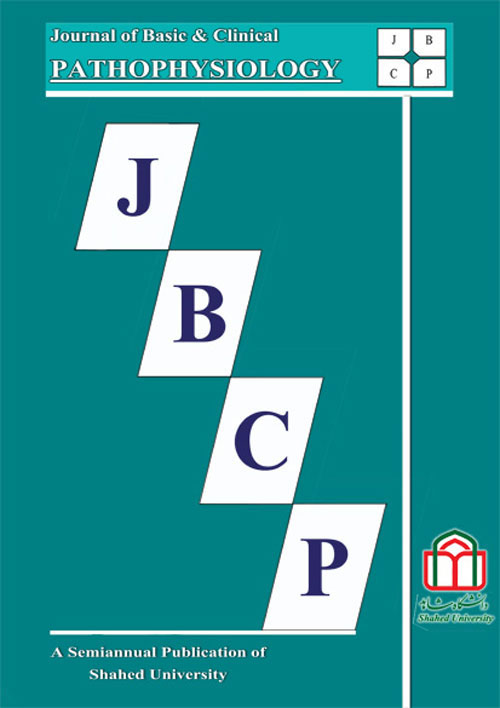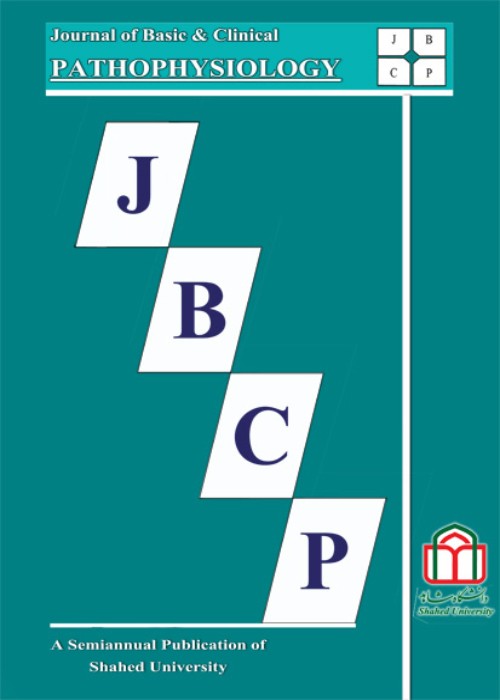فهرست مطالب

Journal of Basic & Clinical Pathophysiology
Volume:9 Issue: 2, Summer-Autumn 2021
- تاریخ انتشار: 1400/10/08
- تعداد عناوین: 7
-
-
Pages 1-10Background and ObjectiveExercise has different physical and psychological benefits and can help ameliorate women’s physical and psychological changes during pregnancy. This study aimed to investigate the effects of exercise during pregnancy on women’s weight gain, health-related quality of life (HR-QOL), and depression, and neonates’ birth weight and type of childbirth.Materials and MethodsOne hundred women who referred to Mostafa Khomeini Hospital (Tehran) from December 2016 to November 2017 for prenatal care were included into this study and randomized into two groups: the case group (n=50) with women whom exercised for 60 minutes 3 times a week for 12 weeks and the control group (n=50) with no exercise. At baseline and after 12 weeks, both groups completed SF-36 and Edinburg questionnaires for assessing their HR-QOL and depression, respectively. The type of childbirth, neonate’s birth weight, and women’s weight after childbirth were recorded.ResultsThe case group had a significantly lower mean ±SD weight gain after 12 weeks as compared with the control group (4.9±1.50 kg vs 6.50±2.47 kg) (P=0.007), and a lower rate of cesarean section (P=0.001). The mean ±SD of neonates’ birth weight was not different between the two groups (P=0.89). The total scores of SF-36, physical and social dimensions, and general health improved in the case group, while significantly decreased in the control group (P<0.05).ConclusionExercise during pregnancy can reduce cesarean section rate and results in less weight gain after pregnancy. It can also improve patients’ HR-QOL and decrease depression. Therefore, it is suggested to be included in the prenatal care protocol.Keywords: Exercise, Pregnancy, Quality of Life, Depression
-
Pages 11-14BackgroundFungal infections of nail can occur in people with brittle and dry skin. This condition can lead to nail damage and infection that spread beyond your feet if you have a suppressed immune system due to medication, diabetes or other conditions. If the immune system is suppressed due to medication, diabetes or other conditions, they expand. Some patients do not respond appropriately to common treatments. The use of platelet rich fibrin membrane (PRF M) has been suggested as an alternative method for fungal infection of nail treatment due to their potential to release many kinds of growth factors and antifungal efficacy.Materials and MethodsThe PRF M sample was obtained from the patient with fungal nail infection. PRF M was harvested from peripheral blood by centrifuging immediately. Moreover, PRF M was expanded over the damaged area in flat form five times for three days. Pre-treatment and post-treatment were then analyzed by observation of fungal infection.ResultsVisual observation showed the positive effect of this technique on the patient's recovery. Hence, it can be deduced that autologous PRF M is a promising safe therapy for drug-resistant fungal infections.ConclusionThe present clinical case report demonstrated that PRF M may be able to remove fungal infections in human.Keywords: Platelet rich fibrin membranes, Fungal infection of nail, antifungal efficacy, regeneration
-
Pages 15-21ObjectiveThe current study aimed at evaluating the effect of flavonoid apigenin on contractile response and relaxation of aorta in streptozotocin (STZ)-induced diabetic rats.Materials and MethodsThirty-two rats were randomly divided into four groups of control, apigenin, diabetic (DM), and DM + apigenin. DM was induced in rats using intraperitoneal (i.p.) injection of STZ at 60 mg/kg. The two treatment groups received apigenin at a dose of 10 mg/kg i.p. every other day for four weeks. At the end of the study, the contractile responses of aorta to potassium chloride (KCL), phenylephrine (PE), and the relaxation response of the aorta to acetylcholine (ACh) were measured.ResultsTreatment with apigenin significantly reduced plasma glucose in diabetic rats in the 2nd and 4th weeks as compared to those of the DM group (P = 0.01). The DM+apigenin group had less contractile response as compared to that of the DM group, although the difference was not statistically significant (P >0.05). Treatment of diabetic rats with apigenin could significantly reduce the maximum contractile response as compared to that of the DM group (P = 0.05). The contractile response to ACh was significantly higher in the DM + apigenin group as compared to that of the DM group (P = 0.05).ConclusionThe results of the current study indicated the hypoglycemic effects of apigenin in diabetic rats. In addition, it was observed that the administration of apigenin to diabetic and healthy rats could reduce contractile response of aorta to PE and increase the relaxation response to ACh.Keywords: Apigenin, Diabetes mellitus, Aorta, Streptozotocin, Endothelium
-
Pages 22-31Background and ObjectiveDepressive disorders are the most prevalent form of the mental disorders in postmenopausal and there is information for beneficial effects of the metformin (MET) in depression. However, there is no report on anti-depressant effect of the MET during postmenopausal period. Thus, the aim of this study was to determine anti-depressant effect of the MET in ovariectomized (OVX) mice and possible involvement of nitrergic and serotoninergic systems.Materials and MethodsTwo hundred and fifty female NMRI mice were randomly allocated into 5 experimental groups (each with 5 groups [A-E], n=50). In experiment 1, mice allocated as (A) control, (B) OVX injected with saline, (C) OVX injected with MET (100 mg/kg), (D) OVX mice injected with MET (200 mg/kg), (E) OVX injected with MET (400 mg/kg) at 24, 6 and 1 h prior the test. In experiment 2, experimental grouping was (A) control, (B) OVX injected with saline, (C) OVX mice injected with MET (400 mg/kg), (D) OVX mice injected with L-NAME (10 mg/kg), (E) OVX mice injected with MET (400 mg/kg) + L-NAME (10 mg/kg). Experiments 3-5 were similar to experiment 2, except OVX mice injected with L-arginine (50 mg/kg), cyproheptadine (4 mg/kg) and fluoxetine (5 mg/kg) instead of L-arginine. Following injections forced swimming test (FST), tail suspension test (TST) and open field test (OFT) were done. At the end of the study, serum malondialdehyde (MDA), superoxide dismutase (SOD), glutathione peroxidase (GPx) and total antioxidant status (TAS) were determined.ResultsAccording to the results, MET (200 and 400 mg/kg) decreased immobility time in TST and FST (P<0.05). Co-injection of the MET+L-NAME decreased immobility time in TST and FST (P<0.05). Co-injection of MET+L-arginine significantly diminished antidepressant activity of the MET (P<0.05). MET + cyproheptadine decreased antidepressant activity of the MET (P<0.05). MET + fluoxetine significantly amplified antidepressant activity of the MET (P<0.05). MET (200 and 400mg/kg) improved serum MDA, SOD and GPx levels (P<0.05).ConclusionIt seems that antidepressant activity of the MET is mediated by nitrergic and serotoninergic system in OVX mice.Keywords: Depression, Ovariectomy, Metformin, Nitric oxide, Serotonin, antioxidant, Estradiol deficiency
-
Pages 32-41Background and ObjectiveDepression is known as the most prevalent mental disorder and there is growing interest to use medical plants with lower side effects. So, the aim of current study was to determine anti-depressant effect of Artemisia dracunculus extract (ADE) in ovariectomized (OVX) mice and its possible interaction with opioidergic, GABAergic and serotoninergic systems.Materials and MethodsIn experiment 1, mice were kept as control and sham groups, OVX, OVX+ ADE (12.5 mg/kg), OVX+ ADE (25 mg/kg) and OVX+ADE (50 mg/kg). In experiment 2, mice kept as control and sham, OVX, OVX+ ADE (50 mg/kg), OVX+naloxone (2 mg/kg) and OVX+injection of ADE and naloxone. Experiments 3-5 were similar to experiment 2, except injections of the flumazenil (5 mg/kg), fluoxetine (5 mg/kg) and cyproheptadine (4 mg/kg). Then, forced swimming test (FST), tail suspension test (TST) and open field test (OFT) tests were done. Also, serum malondialdehyde (MDA), superoxide dismutase (SOD), glutathione peroxidase (GPx) and total antioxidant status (TAS) levels were determined.ResultsAccording to the findings, OVX increased immobility time compared to control group (P<0.05). ADE (50 mg/kg) decreased depression induced immobility time compared to OVX group (P<0.05). Injection of ADE+flumazenil decreased depression induced immobility time in TST and FST and increased number of crossing in OFT (P<0.05). Injection of ADE+fluoxetine decreased depression induced immobility time (P<0.05). ADE (25 and 50 mg/kg) reduced the MDA while elevated SOD and GPx levels in OVX mice (P<0.05).ConclusionIt seems that antidepressant activity of Artemisia dracunculus is mediated via GABAergic and serotoninergic systems in OVX mice.Keywords: Anti-depressant, Ovariectomy, Artemisia dracunculus, GABAergic, Serotoninergic
-
Pages 42-48ObjectivePresent study investigated the effect of tobacco-specific carcinogen, nicotine-derived nitrosamine ketone (NNK), on the expression of cellular stress response genes in lung tissue of Wistar rats. Moreover, the effect of exercise training on alterations of these genes in exposed rats was investigated.Materials and MethodsA total of 30 healthy Wistar rats were obtained and divided into the following group: (1) Control (CON), (2) NNK exposure (NNK, once a week / 12.5 mg per kg body mass for 12 weeks), and NNK + swimming training (NNK+ST, received NNK exposure + 25-60 min of aerobic swimming training / 5 days per week for 12 weeks). The mRNA expression level of nuclear factor kappa-B (NF-κB), forkhead box protein O3 (FOXO3), and Sirtuin-1 (Sirt-1) were determined in lung tissue by the quantitative real-time PCR.ResultsThe NNK exposure resulted in a significant reduction in mRNA expression of the NF-κB and FOXO3 (P=0.0001 and P=0.005, respectively), as well as a significant increment in mRNA expression of Sirt-1 (P=0.001) comparing to the CON group. Moreover, the ST in rats under NNK treatment led to a significant reduction in mRNA expression of NF-κB (P=0.0001), but it did not have any significant effect on mRNA expression of FOXO3 and Sirt-1 (P>0.05) comparing to the NNK group.ConclusionThese findings indicate that NNK exposure can lead to adverse alterations in the expression of cellular stress response genes in the lung tissue of Wistar rats and exercise training may not have any favorable effect on the expression of these genes in rats under NNK treatment.Keywords: 4-(methylnitrosamino)-1-(3-pyridyl)-1-butanone, Cell Stress, Pulmonary, Swimming training


